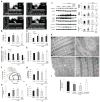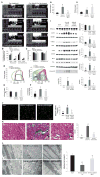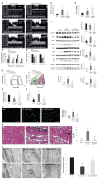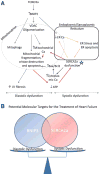Potential role of BNIP3 in cardiac remodeling, myocardial stiffness, and endoplasmic reticulum: mitochondrial calcium homeostasis in diastolic and systolic heart failure
- PMID: 23508759
- PMCID: PMC3909701
- DOI: 10.1161/CIRCHEARTFAILURE.112.000200
Potential role of BNIP3 in cardiac remodeling, myocardial stiffness, and endoplasmic reticulum: mitochondrial calcium homeostasis in diastolic and systolic heart failure
Abstract
Background: We have shown that BNIP3 expression is significantly increased in heart failure (HF). In this study, we tested the effects of BNIP3 manipulation in HF.
Methods and results: In a rat model of pressure overload HF, BNIP3 knockdown significantly decreased left ventricular (LV) volumes with significant improvement in LV diastolic and systolic function. There were significant decreases in myocardial apoptosis and LV interstitial fibrosis. Ultrastructurally, BNIP3 knockdown attenuated mitochondrial fragmentation and restored mitochondrial morphology and integrity. On the molecular level, there were significant decreases in endoplasmic reticulum (ER) stress and mitochondrial apoptotic markers. One of the mechanisms by which BNIP3 mediates mitochondrial dysfunction is via the oligomerization of the voltage-dependent anion channels causing a shift of calcium from the ER to mitochondrial compartments, leading to the decrease in ER calcium content, mitochondrial damage, apoptosis, and LV interstitial fibrosis, and hence contributes to both systolic and diastolic myocardial dysfunction, respectively. In systolic HF, the downregulation of SERCA2a (sarcoplasmic-endoplasmic reticulum calcium ATPase), along with an increased BNIP3 expression, further worsen myocardial diastolic and systolic function and contribute to the major remodeling seen in systolic HF as compared with diastolic HF with normal SERCA2a expression.
Conclusions: The increase in BNIP3 expression contributes mainly to myocardial diastolic dysfunction through mitochondrial apoptosis, LV interstitial fibrosis, and to some extent to myocardial systolic dysfunction attributable to the shift of calcium from the ER to the mitochondria and to the decrease in ER calcium content. However, SERCA2a downregulation remains a prerequisite for the major LV remodeling seen in systolic HF.
Keywords: apoptosis; gene therapy; heart failure; hypertrophy; remodeling.
Figures







Similar articles
-
FOXO3a regulates BNIP3 and modulates mitochondrial calcium, dynamics, and function in cardiac stress.Am J Physiol Heart Circ Physiol. 2016 Dec 1;311(6):H1540-H1559. doi: 10.1152/ajpheart.00549.2016. Epub 2016 Sep 30. Am J Physiol Heart Circ Physiol. 2016. PMID: 27694219 Free PMC article.
-
[Adeno-associated viral gene transfer of SERCA2a improves heart function in chronic congestive heart failure rats].Zhonghua Xin Xue Guan Bing Za Zhi. 2006 Apr;34(4):357-62. Zhonghua Xin Xue Guan Bing Za Zhi. 2006. PMID: 16776934 Chinese.
-
Redox-Resistant SERCA [Sarco(endo)plasmic Reticulum Calcium ATPase] Attenuates Oxidant-Stimulated Mitochondrial Calcium and Apoptosis in Cardiac Myocytes and Pressure Overload-Induced Myocardial Failure in Mice.Circulation. 2020 Dec 22;142(25):2459-2469. doi: 10.1161/CIRCULATIONAHA.120.048183. Epub 2020 Oct 20. Circulation. 2020. PMID: 33076678 Free PMC article.
-
Targeting BNIP3 in inflammation-mediated heart failure: a novel concept in heart failure therapy.Heart Fail Rev. 2016 Sep;21(5):489-97. doi: 10.1007/s10741-016-9557-4. Heart Fail Rev. 2016. PMID: 27112557 Review.
-
Clinical aspects of left ventricular diastolic function assessed by Doppler echocardiography following acute myocardial infarction.Dan Med Bull. 2001 Nov;48(4):199-210. Dan Med Bull. 2001. PMID: 11767125 Review.
Cited by
-
Mitochondrial Contact Sites in Inflammation-Induced Cardiovascular Disease.Front Cell Dev Biol. 2020 Jul 30;8:692. doi: 10.3389/fcell.2020.00692. eCollection 2020. Front Cell Dev Biol. 2020. PMID: 32903766 Free PMC article. Review.
-
Human Neural Stem Cell Systems to Explore Pathogen-Related Neurodevelopmental and Neurodegenerative Disorders.Cells. 2020 Aug 12;9(8):1893. doi: 10.3390/cells9081893. Cells. 2020. PMID: 32806773 Free PMC article. Review.
-
Mitochondrial dysfunction in human hypertrophic cardiomyopathy is linked to cardiomyocyte architecture disruption and corrected by improving NADH-driven mitochondrial respiration.Eur Heart J. 2023 Apr 1;44(13):1170-1185. doi: 10.1093/eurheartj/ehad028. Eur Heart J. 2023. PMID: 36734059 Free PMC article.
-
Multi-Omics Approach Profiling Metabolic Remodeling in Early Systolic Dysfunction and in Overt Systolic Heart Failure.Int J Mol Sci. 2021 Dec 26;23(1):235. doi: 10.3390/ijms23010235. Int J Mol Sci. 2021. PMID: 35008662 Free PMC article.
-
Mitochondrial dysfunction in cancer.Front Oncol. 2013 Dec 2;3:292. doi: 10.3389/fonc.2013.00292. Front Oncol. 2013. PMID: 24350057 Free PMC article. Review.
References
-
- Gang H, Hai Y, Dhingra R, Gordon JW, Yurkova N, Aviv Y, Li H, Aguilar F, Marshall A, Leygue E, Kirshenbaum LA. A novel hypoxia-inducible spliced variant of mitochondrial death gene bnip3 promotes survival of ventricular myocytes. Circ Res. 2011;108:1084–1092. - PubMed
Publication types
MeSH terms
Substances
Grants and funding
LinkOut - more resources
Full Text Sources
Other Literature Sources
Research Materials
Miscellaneous

